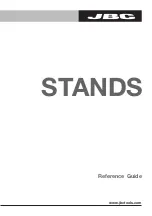
5
English
Contact with a “live” wire will make exposed
metal parts of the tool “live” and shock the
operator.
2. Use clamps or another practical way to
secure and support the workpiece to a
stable platform.
Holding the work by hand or against your body
leaves it unstable and may lead to loss of
control.
3. Always wear ear protectors when using the
tool for extended periods.
Prolonged exposure to high intensity
noise can cause hearing loss.
4. Handle the bits very carefully.
5. Check the bit carefully for cracks or damage
before operation. Replace cracked or
damaged bit immediately.
6. Avoid cutting nails. Inspect for and
remove all nails from the workpiece before
operation.
7. Hold the tool
fi
rmly with both hands.
8. Keep hands away from rotating parts.
9. Make sure the bit is not contacting the
workpiece before the switch is turned on.
10. Before using the tool on an actual workpiece,
let it run for a while. Watch for vibration or
wobbling that could indicate improperly
installed bit.
11. Be careful of the bit rotating direction and
the feed direction.
12. Do not leave the tool running. Operate the
tool only when hand-held.
13. Always switch o
ff
and wait for the bit to
come to a complete stop before removing
the tool from workpiece.
14. Do not touch the bit immediately after
operation: it may be extremely hot and
could burn your skin.
15. Always lead the power supply cord away
from the tool towards the rear.
16. After changing the bits or making any
adjustments, make sure the collet nut and
any other adjustment devices are securely
tightened.
Loose adjustment device can unexpectedly
shift, causing loss of control, loose rotating
components will be violently thrown.
17. Always wear eye protection that meets the
requirement of the latest revision
of ANSI Standard Z87.1.
18. De
fi
nitions for symbols used on this tool
V
............ volts
Hz
.......... hertz
A
............ amperes
........... no load speed
W
........... watt
.......... Class II Construction
---/min
...
revolutions or reciprocation per
minute
.......... Alternating current
DOUBLE INSULATION FOR SAFER
OPERATION
To ensure safer operation of this power tool, HITACHI
has adopted a double insulation design. “Double
insulation” means that two physically separated
insulation systems have been used to insulate the
electrically conductive materials connected to the
power supply from the outer frame handled by the
operator. Therefore, either the symbol “
” or the
words “Double insulation” appear on the power tool
or on the nameplate.
Although this system has no external grounding,
you must still follow the normal electrical safety
precautions given in this Instruction Manual,
including not using the power tool in wet
environments.
To keep the double insulation system e
ff
ective,
follow these precautions:
○
Only Hitachi Authorized Service Center should
disassemble or assemble this power tool, and
only genuine HITACHI replacement parts should
be installed.
○
Clean the exterior of the power tool only with a
soft cloth moistened with soapy water, and dry
thoroughly.
Never use solvents, gasoline or thinners on
plastic components; otherwise the plastic may
dissolve.
000Book̲M12VE̲US.indb 5
000Book̲M12VE̲US.indb 5
2009/08/06 18:23:05
2009/08/06 18:23:05
Содержание M 12VE
Страница 41: ...41 000Book M12VE US indb 41 000Book M12VE US indb 41 2009 08 06 18 23 08 2009 08 06 18 23 08 ...
Страница 42: ...42 000Book M12VE US indb 42 000Book M12VE US indb 42 2009 08 06 18 23 08 2009 08 06 18 23 08 ...
Страница 43: ...43 000Book M12VE US indb 43 000Book M12VE US indb 43 2009 08 06 18 23 08 2009 08 06 18 23 08 ...






































